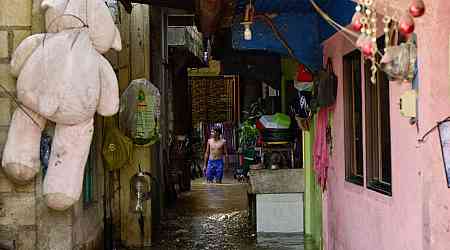
The Philippines is known for its monthslong Christmas celebrations starting in September. The heavily Catholic country of nearly 120 million people is serious about the festive season. However, this time of year has recently taken a much more somber tone for many Filipino families.
[time-brightcove not-tgx=”true”]Estrella Pagarigan had decorated her home with recycled bamboo and plastic bottle parols for the holidays, but in early November, the house where she, her husband, and three children have lived for years was flattened overnight. Typhoon Yinxing, locally known as Marce, had brushed through the northern part of the Southeast Asian country and wreaked havoc in Pagarigan’s province of Cagayan. Their home—which had withstood previous natural disasters—was one of more than a thousand that was razed in the administrative region.
“It was exceptional,” Pagarigan tells TIME of the Category 4-equivalent storm. Christmas certainly won’t be as merry, she said.
Such so-called super typhoons are becoming more and more common for the Philippines, exacerbated by climate change. The country faces an average of 20 tropical cyclones per year, according to the national weather bureau. It is part of the Pacific Typhoon Belt, and has an active typhoon season that normally runs from July to October, when 70% of the year’s typhoons form. But increasingly, the holiday season—which is usually associated with dryer temperatures—is seeing strong typhoons too, like in 2021, when Super Typhoon Rai (a Category-5 equivalent) came in early December and caused nearly $1 billion in damages.
2024 has been relentless: in less than a month between October and November, six tropical cyclones—including Marce—entered the country, affecting millions across the archipelago and causing over $350 million in damages to infrastructure and agriculture. In the wake of the onslaught, the Office of the President urged government workers to avoid lavish holiday gatherings, “adopt austerity in their celebrations,” and encouraged donations to victims. “This call is in solidarity with the millions of our countrymen who continue to grieve over lives, homes, and livelihoods lost during the six typhoons that pummeled us in a span of less than a month,” Executive Secretary Lucas Bersamin said in a statement. The Department of Education similarly called on schools to scale down Christmas parties.
Climate experts in the country have sounded the alarm about an increase of what some are calling “Christmas typhoons.” According to a 2021 study by Joseph Basconcillo and Il-Ju Moon, the frequency of typhoons in the Philippines during the usually less active season—December to February—increased by 210%, between 2012 and 2020. Basconcillo tells TIME that with the analysis extended to 2022, that figure would rise to 240%. “There’s a false sense of security associated with the less active season,” he says. “Because there’s less frequent tropical cyclones, and, of course, the spirit of celebration.”

The recent increase in Christmas typhoons is not conclusively caused by man-made climate change. Instead, Basconcillo and Moon’s paper links it to the Pacific Decadal Oscillation—which, according to the U.S. National Oceanic and Atmospheric Administration, is “a long-lived El Niño-like pattern of Pacific climate variability,” like a see-saw of warm and cool phases that alternates approximately every 20 to 30 years.
Gerry Bagtasa, an atmospheric physicist and professor at the University of the Philippines, who has also studied the phenomenon, says that Christmas typhoons in the country will likely become more frequent, but not permanently. “There is an upward trend starting from around 15-20 years [ago], but this may not go on in the next decades,” Bagtasa emailed TIME. Basconcillo says the biggest takeaway should be that better preparedness is needed in the Philippines for typhoons regardless of when they may occur.
For 31-year-old Paolo Mari—who lives near the Marikina River, an area in the national capital region that is flood-prone every time inclement weather strikes and where evacuations are common—a more cautious mentality has clearly somewhat dampened the local holiday enthusiasm: “We just prepare food. But making decorations and Christmas trees—we don’t put up anything anymore,” he says. “It’s kind of rare in houses here. … It’s impractical to the area, due to flooding and stuff.”
Others, however, see the Christmas spirit persist in the resilience of communities impacted by typhoons. In the province of Albay some 185 mi. southeast of capital Manila, local disaster risk reduction and management officer Ian James Secillano tells TIME that in the recently severely-affected community of Libon (pop. 84,000) many have chosen to carry on with holiday cheer despite the calamity. They’ve simply shifted the focus from fancy parties and ornate displays to relief and outreach operations. “The spirit is still the same,” he says, “but there will just be changes on how resources are coursed through.”




























